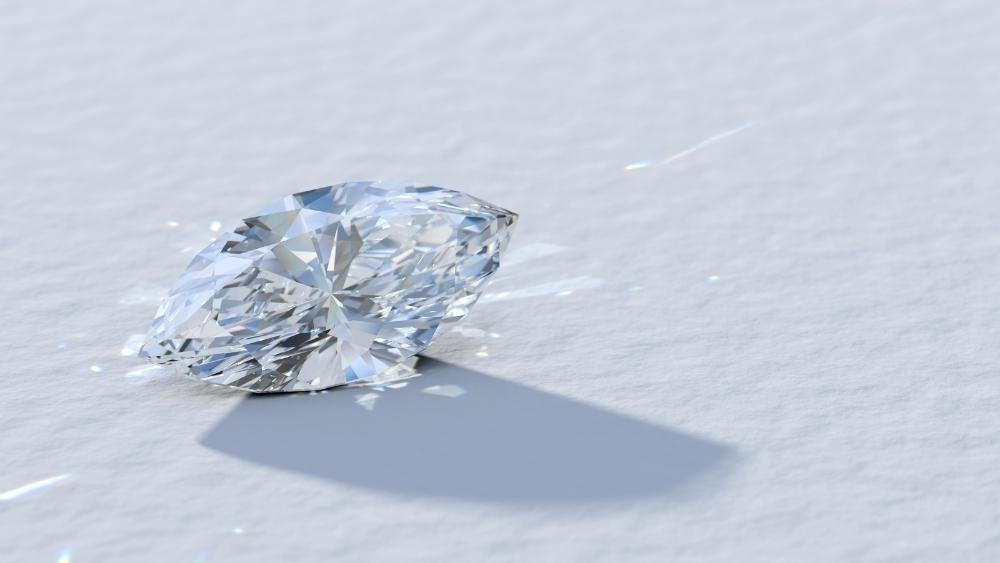
Marquise Cut Diamond Guide | Diamond Buzz
[ad_1]
Marquise cut diamonds are unique, elegant and relatively rare. Due to their elongated and narrow shape, they look larger than all other diamond cuts of the same carat weight. If you are interested in buying a stone with an aristocratic air and a unique shape, this marquise cut diamond guide is a must-read.History of Marquise Cut DiamondsPurchase a license for the rights to use this graphic imageMarquise cut has a royal pedigree and a truly fascinating history that dates back to 18th century France.The legend has it that the original cut was created for the Marquise de Pompadour, the official chief mistress of King Louis XV. In the 1740s, the King requested his jeweller to design a cut which outline would resemble the shape of the Marquise’s mouth. No surprise, the courtiers of the time wore marquise cut diamonds to demonstrate their high rank.Due to its boat-like shape, the marquise cut was also one of the favourite diamond cuts of the early 20th century Edwardians because sailing was a hobby of King Edward VII and his contemporaries. That is why the cut is often referred to as navette, which means “little ship” in French.The design of the modern marquise cut has been perfected into a distinctive shape with curved sides and pointed ends, but it is still similar to the original cut. It typically features 58 facets; however, depending on the modification of the cut, the number of the facets can go up to 71. Due to its elongated shape, the marquise cut appears larger than other diamond cuts of the same carat weight, as well as makes the wearer’s fingers look longer and thinner.Marquise Cut Diamond Cut QualityPurchase a license for the rights to use this graphic imageWhile the Gemological Institute of America (GIA) and other lab entities provide cut grading for the round brilliant cut, they do not give a cut quality grade for fancy shaped diamonds, including the marquise cut. This is because fancy shapes have many non-standardised facet structures, meaning they can be cut to a wide range of proportions. However, grading laboratories list information on polish and symmetry, which are some of the key factors to choosing a brilliant and sparkly stone.When choosing a marquise cut diamond, make sure to pay attention to the facets of the stone and their symmetry. The facets on the right and left halves should have the same shape. All the points of the facets should meet, and there should not be missing or extra ones. An ideal marquise cut diamond should possess an excellent symmetry, meaning the pointed ends and curves should line up with each other.Due to their elongated shape, most marquise diamonds cut in the brilliant style exhibit a bowtie effect, which occurs when some of the entering light leaks out from the centre of the stone and does not bounce back to the table. Sometimes the effect is easily noticeable, and other times it is hardly visible. It gets darker as the length to width ratio increases, and pavilion angle variations become more extreme. The thing is that a prominent bowtie effect distracts from the beauty of the stone, which is why you should make sure the diamond you choose does not have a dominant bowtie, meaning it should not be the first thing you notice when looking at a marquise cut diamond.Since there is no industry-wide consent on what cut parameters make an ideal marquise cut diamond, it is recommended to use the table below as a general guideline for evaluating the cut quality of marquise diamonds. EXCELLENTVERY GOODGOODFAIRPOORTABLE %53 – 6352 or 64 – 6551 or 66 – 6850 or 69 – 70 70DEPTH %58 – 6256 – 57.9 or 62.1 – 6653 – 55.9 or 66.1 – 7150 – 52.9 or 71.1 – 74 74GIRDLEVery Thin to Slightly ThickVery Thin to Slightly ThickVery Thin to ThickVery Thin to Very ThickExtremely Thin to Extremely ThickCULETNoneVery SmallSmallMedium> MediumLENGTH TO WIDTH RATIO1.85 – 2.001.75 – 1.84 or 2.01 – 2.151.65 – 1.74 or 2.16 – 2.301.55 – 1.64 or 2.31 – 2.45> 1.55 or Marquise Cut Diamond ColourThe colour of marquise cut diamonds is graded on a scale from D to Z, where D signifies a completely colourless stone and Z means an easily noticeable yellow or brown tint.As a general rule, smaller marquise cut diamonds, those weighing 0.50 carats and less, hide colour better than larger ones. That is why, depending on the size of the diamond you are going to purchase, you may not need to buy a premium colourless stone, even if you want it to look white. While it is usually impossible to see the difference between two colour grades for an untrained eye, the price difference can be significant.In general, it is recommended to opt for H colour or better to have a diamond that will appear white and colourless to the naked eye. However, keep in mind that colour should be compared on a case-by-case basis.The chart below provides a general guideline for evaluating colour in the marquise cut diamonds based on their carat weight.SIZEEXCELLENTVERY GOODGOODFAIRPOORD – GH – IJ – KL – M> M.51 – 1.0 ct.D – FGH – IJ – K> K1.0 – 2.0 ct.D – FD – FG – HI – J> J> 2.0 ct.D – FD – FGH – I> I Marquise Cut Diamond ClarityThe GIA grades clarity of marquise cut diamonds on a scale from FL to I3, where FL means a flawless stone and I3 indicates a heavily included diamond.The issue of clarity is the same in all diamonds. Depending on their type, inclusions can affect the brilliance and fire of a diamond. However, marquise cut diamonds, due to their unique cutting style, tend to hide inclusions well, especially if the flaws are at the tapered ends. Moreover, smaller marquise cut diamonds hide imperfections better than larger ones do, which is why if you are going to purchase a smaller stone, you may opt for a lower clarity grade such as SI1 and SI2 while keeping an eye-clean appearance.The clarity chart below provides a general guideline for choosing the right marquise diamond based on your inclusion tolerance.SIZEEXCELLENTVERY GOODGOODFAIRPOORFL – VS2SI1 – SI2I1I2> I2.51 – 1.0 ct.FL – VS1VS2 – SI1SI2I1 – I2> I21.0 – 2.0 ct.FL – VVS2VS1 – VS2SI1 – SI2I1> I1> 2.0 ct.FL – VVS2VS1 – VS2SI1SI2> SI2 Marquise Cut Diamond Length to Width RatioPurchase a license for the rights to use this graphic imageThe length to width ratio expresses how relatively long or wide a diamond appears. It is calculated by dividing the length of the diamond by its width. For example, if the length of a marquise cut diamond is 12.30mm and the width is 5.80mm, its length to width ratio is 2.1.Each fancy diamond shape has a certain length to width ratio that is considered most appealing for that shape. While personal preference prevails, the optimal ratio for marquise diamonds is between 1.75 – 2.15. The higher the ratio, the thinner the diamond looks.Post navigation
http://sxd.dongnai.gov.vn/Lists/HisCounter/DispForm.aspx?ID=2028975
http://www.alexandria.gov.eg/Lists/comp_new/DispForm.aspx?ID=829396
http://www.stc.quangnam.gov.vn/Default.aspx?tabid=167&TLID=2416
https://dichvucong.namdinh.gov.vn/portaldvc/lists/HoiDap/DispForm.aspx?ID=479
http://research.psut.edu.jo/Lists/WebsiteSurvey/DispForm.aspx?ID=25865
https://www.gov.bn/Lists/eDarussalam%20Survey/DispForm.aspx?ID=69658
[ad_2]

